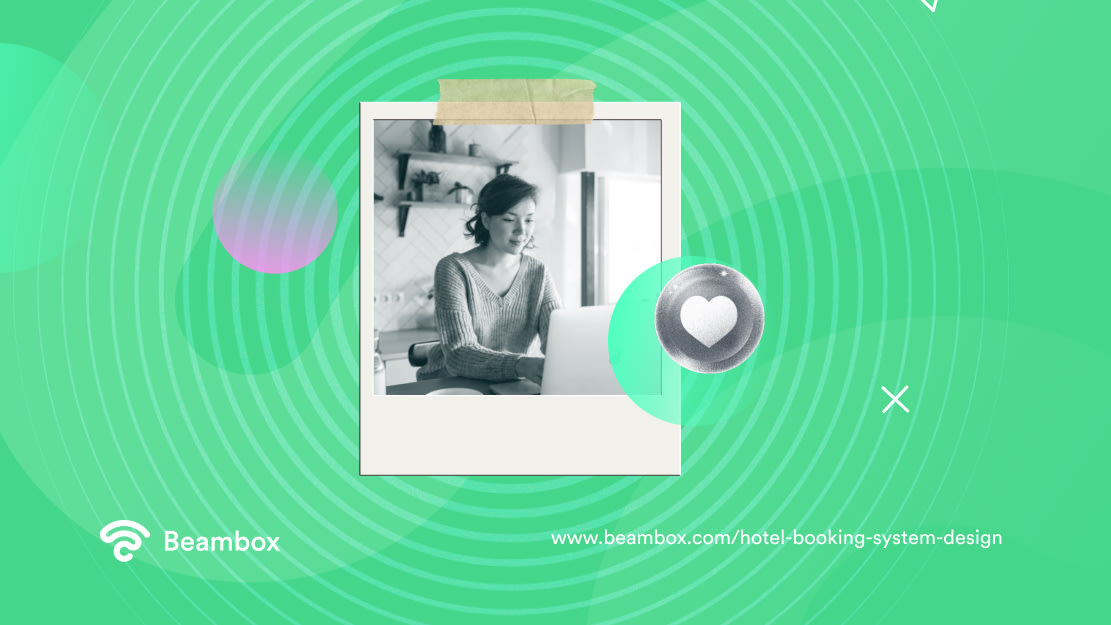Hotel Booking System Design: 5 Steps to an Efficient Website
Selling your rooms is easy when you offer the right necessities. But how will you manage those bookings without a good hotel booking system design?
Using a pen and paper to manage modern hotel bookings would be impossible for your staff. You might not even make as much hotel revenue as you would with a proper tool.
However, designing such a tool isn’t easy, especially since customers demand an immersive experience. So, let’s take a look at five steps you can take to design hotel booking software.

Top 5 Features of a Hotel Booking System Design
Before learning how to design a hotel booking system, let’s discuss the top five features of such a system. It’s a good idea to know what goes into your system, even if you hire professional help to create it. This way, you’ll be more capable of navigating the system.
So, here’s a look at the five most essential components of a hotel booking system:
- Booking engine: It doesn’t make sense to have a booking website that doesn’t let guests reserve their rooms online. Therefore, your system must have a booking engine, at the very least.
- Integrations: Your hotel reservation system must integrate with other channels to let you take bookings via multiple sources. For example, a customer can book rooms using their email address through form integrations.
- Channel manager: Having multiple revenue sources needs a robust channel manager to manage those bookings.
- Online payments: There’s little use in letting customers book their rooms through the system without accepting online payments. This makes revenue management critical. People should be able to link their credit cards or digital wallets securely for enhanced guest experiences.
- User-friendliness: You won’t get many online bookings if your system isn’t easy to use. So, focus on easier interfaces that balance interactivity with simplicity.
How To Design a Hotel Booking System in 5 Simple Steps
Online tools like Airbnb and Hotel Extranet have made it extremely easy for businesses to take room bookings. Therefore, designing a hotel booking system might sound like a waste of time and money.
However, a dedicated booking system makes your brand look authoritative and reinforces your branding. It also gives you more control over how you want to take reservations through the hotel website.
Besides, these systems bring unique advantages, such as tailored guest experiences and data-driven management insights. They can even help you streamline your operations and increase profits. So, here’s how you can create such a system in five easy steps.

1. Understand Your Target Market
Whether you’re creating email marketing strategies, new products, or booking systems, the process starts with understanding your target audience. After all, you want to give your guests an easy and enjoyable experience when using your system.
So, contact your ideal customers and conduct surveys. Ask them what they like about existing booking engines and what they think needs improvement. You can even ask about specific design elements to add to your system. For example, you’ll need to make the design more visually dynamic and interactive if you’re targeting younger people.
2. Make Your Brand Recognizable
It doesn’t make sense to design a hotel booking system without incorporating your branding elements. It’s your chance to reinforce what you stand for while making the system visually appealing. For this, you can create simple branding yourself if you have the eye for creativity or hire a designer.
The first line of action is to create a logo for your business. Try to capture the essence of your entire hotel within that logo. You’ll also have to choose colors, patterns, verbal language, and themes that go with your brand.
Branding is one of the reasons why the Gaylord Hotels website is so popular. However, you don’t have to worry about this step if you already have branding.

3. Hire a Designer or Invest in a Website Builder
Designing a booking system requires extensive technical knowledge. It’s not just about the visuals. You also need to think about attaching a database, front-end programming, and back-end programming. For this, you have two options – using website builders to create your system or hiring a professional designer.
The first option is much more cost-effective since you’ll have templates and tools to create the system yourself.
On the other hand, you’ll get more control over the system and its customization if you hire a professional. They’ll bring in their expertise and even help you update the system in the future. However, this option can get expensive really quickly.
4. Incorporate a Hotel Booking System Database Design
Once you know how you want to create the system, you’ll have to think about hotel inventory. You need a proper database to store information about your rooms and customers so you can avoid double bookings.
Basically, you’ll be dealing with tables that might interconnect with each other. There will be a table for users, hotels (if you have multiple locations,) rooms, bookings, business reviews, and payments. These tables will have multiple columns for the data you want to store. You can choose to save as much or as little data as you want.
Then, think about the relationships between these tables. Payment tables will relate to bookings and users at a basic level and to all tables at an advanced level.
5. Nail Your Search Engine Optimization Strategy (SEO)
People usually turn to Google when they want to book a room. While online channels are popular for this purpose, nothing beats a dedicated booking system. Customers trust your brand when they see a proper website popping up as an answer to their queries.
But for that, you need to optimize your website for search engines. It should be the first one when guests search for a room similar to what you’re offering. As a result, you’ll get more direct bookings than any other channel.

Keep Your Hotel Website User-Centric To Enjoy Better Results
A hotel booking system design goes beyond functionality for the best possible results. You need to make it user-centric, adding elements that make the user’s experience more enjoyable. Include the basic features like reservation forms, channel management, etc., but combine them with user-friendliness and animations.
On the topic of being user-centric, you could set up WiFi marketing. Simply invest in captive portal software, which blocks WiFi access until guests input their contact details. With these details, you can sync an automatic email marketing campaign.
At Beambox, we made a comprehensive WiFi marketing platform to scale your business. Start your trial today!
Frequently Asked Questions About Hotel Booking System Design
Designing hotel booking software is different from using it. So, let’s answer some frequently asked questions before wrapping things up.
What are the main types of users in a hotel booking system?
The main types of users in a hotel booking system include guests, hotel staff, admins, travel agents, and channel partners.
However, each user group has distinct needs. For example, guests make reservations while staff manage bookings, admins maintain system settings, and travel agents make bookings for clients.
What technologies should be used to develop a hotel booking system?
You should use technologies like website builders, content editors, and software design, as well as front-end and back-end frameworks.
But remember, some of these technologies are quite technical. So, hiring a programmer would be the best option if you aren’t familiar with them.
What are the key features to include in a hotel booking system?
The key features to include in a hotel booking system are real-time room availability, channel management, and profile personalization.
You also need detailed analytics and integration with external systems. These features combine to make a well-rounded hotel booking system for you and your guests.



